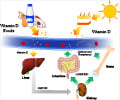Vitamin D deficiency can lead to a much higher risk of developing diabetes. Individuals with 25-hydroxyvitamin D levels below 30 ng/ml are five times at higher risk for developing diabetes.
Highlights
- Deficiency of vitamin D poses a great risk for developing diabetes
- Having blood levels of 25-hydroxyvitamin D above 30 ng/ml can put an individual at one-third of diabetes risk and those with levels above 50 ng/ml at one-fifth of diabetes risk
- Individuals with 25-hydroxyvitamin D levels below 30 ng/ml are five times at higher risk for developing diabetes
The research team followed the participants through 2009, where the levels of vitamin D3 in the blood were measured, along with fasting plasma glucose and oral glucose tolerance.
During this period, there were about 47 new diabetes cases and 337 new cases of pre-diabetes, in which blood sugar levels were found to be higher than normal, but not as high as type 2 diabetes.
The normal estimated level Vitamin D3 or 25-hydroxyvitamin is 20 to 100 ng/ml and a level below 20 is considered as vitamin D deficiency. However, for this study, the minimum level of Vitamin D3 in blood plasma was 10 ng/ml above the recommended level identified at 30 ng/ml.
The minimum level of Vitamin D3 has been a point of debate for many years with some suggesting that this should be at 50 ng/ml, but the National Institute of Medicine has prescribed this to be at 20 ng/ml.
Cedric F. Garland, the co-author, DrPH, adjunct professor in the UC San Diego School of Medicine Department of Family Medicine and Public Health, said that people with 25-hydroxyvitamin D levels below 30 ng/ml were considered to be vitamin D deficient and were five times at higher risk for developing diabetes than those with levels above 50 ng/ml.
Previous epidemiological studies show that the distribution and determinants of various health and disease conditions and do not necessarily prove cause-and-effect.
"Further research is needed on whether high 25-hydroxyvitamin D levels might prevent type 2 diabetes or the transition from pre-diabetes to diabetes. But this paper and past research indicate there is a strong association," said Garland.
Garland and others had long advocated the health benefits of vitamin D.
In 1980, he and his late brother Frank C. Garland, also an epidemiologist, published an influential paper that showed that vitamin D and calcium together reduced the risk of colon cancer.
The Garlands and colleagues subsequently found the link between breast, lung and bladder cancers.
Garland said that to reach 25-hydroxyvitamin D levels of 30 ng/ml; there is a need for dietary supplements of 3,000 to 5,000 international units (IU) per day, which is less with the addition of moderate daily sun exposure with minimal clothing (approximately 10-15 minutes per day outdoors at noon).
Currently, the recommended average daily amount of vitamin D, according to the National Institutes of Health is:
- 400 IU for children up to 1 year
- 600 IU for ages 1 to 70 years (less for pregnant or breastfeeding women) and
- 800 IU for persons over 70
Source-Medindia















